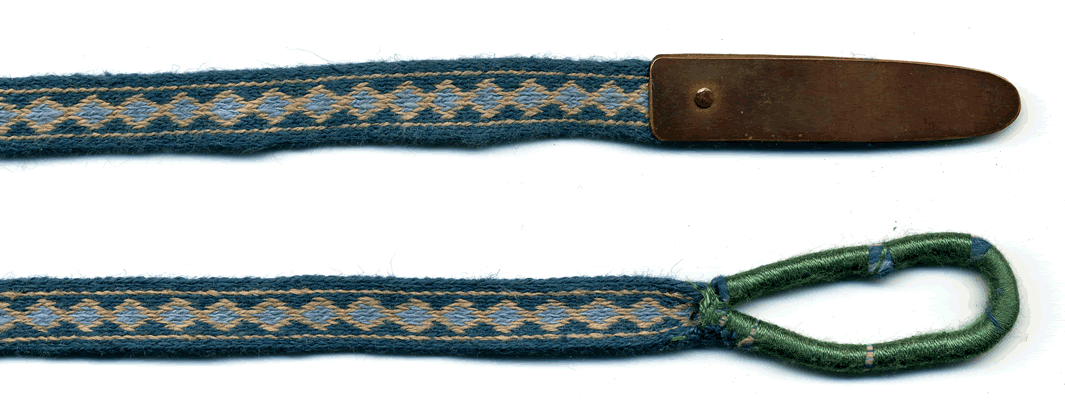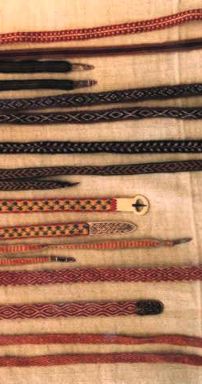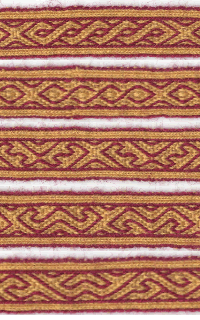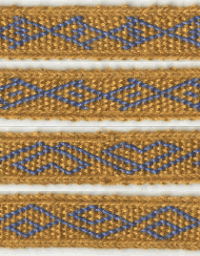Historically this was done with either a back strap method or a structured loom. From Snartemo Nor- way in red blue yellow and green wool 6th century Oseburg ship burial cards and loom for weaving found in the tomb of Queen Asa.
Anglo Saxon Diagonal Greek Key Tablet Weaving Doing It Wrong
4-strand plaiting whipcording vs.
. Anglo-Saxon Tablet Weaving Antiquaries Journal 32 nos. It is present for example in the well-developed tablet braids and edgings of the Torsberg find from Schleswig and therefore might be expected to occur in Anglo-Saxon remains. So we are turning our backs on the term Anglo-Saxon.
On an inkle weaving loom alternate warp. Dark Age Tablet Weaving for Viking and Anglo-Saxon re-enactors 1 Introduction Tablet weaving also known as card weaving is a method of using square tablets with holes in the corners to weave narrow decorative bands made of wool linen or silk threads. The find was dated to about 600 AD.
The oldest known reliable evidence for card weaving comes from about 400 BC. Posted on October 22 2017 April 26 2018. Historically this was done with either a back strap method or a structured loom.
Most belt finds have been leather. Introducción al Tabletweaving o Cardweaving Wefencræft El tablet weaving o card weaving tejido por tablillas es un tipo tradicional de tejido muy popular entre los pueblos de origen germánico. Weaving is slow but the results are pleasing.
Girdle end with textile St. Pattern looks good 10 into the trim. Tablet weaving also known as card weaving is an ingenious technique for taking long bundles of warp threads and passing them through perforated tablets then manipulating these to make strong patterned bands.
To weave with this technique each card is normally. Tablet weaving also known as card weaving is an ingenious technique for taking long bundles of warp threads and passing them through perforated tablets then manipulating these to make strong patterned bands. The term Anglo -Saxon has been co-opted by white supremacists.
It is most appropriate then that the first examples of tablet weav-. Additionally most Anglo-Saxon tablet-woven finds have been plain one-colored weaves with or without additional brocading but this piece is in an uncommon weave containing an uncommon number of colors--three. Tablet weaving is one of the oldest European textile techniques traceable to at least the early iron age.
Anglo Saxon threaded in pattern Band completed 10232002 What it is This tablet woven band is woven using 18 tablets each with 4 strands of size 10 cotton crochet thread a total of 72 threads using the method described as Pack Idling by Peter Collingwood in The Techniques of Tablet Weaving using Thora Sharptooths threading sequence from her website. The tablets are small flat squares usually of bone or wood with a hole in each corner through which a warp thread is passed. Each little swatch represents a different warp.
To weave with this technique each card is normally. Turn only the odd cards beat pull the last weft thread taut. The tablets are held in the hand like a pack of cards parallel to the warp and turned backwards or forwards by half or quarter turns.
Tablet weaving has been popular in the north from the early centuries AD. Grace Crowfoot published an analysis of the weave in 1951. Its a bit strange but if everything is set up correctly the diamond pattern will appear.
Working out the twist is time consuming. Unlike most historic bands the tablets were individually threaded with different coloured threads. The threaded in anglo-saxon double diamonds pattern.
A threaded-in pattern from an early Anglo-Saxon or mediaeval find Description A small piece of linen1 tablet weaving was found attached to a bronze strap-end in St Johns Cricket Field Cambridge. A comparison of lucet vs. Twisting a tablet works by turning it around the axis that runs across from the AD edge to the BC edge of the tablet the warp threads swap from S to Z threading or vice versa and the AD and BC positions are swapped.
CROWFOOT TABLET weaving has been popular in the north from the early AD centurie I. To begin with it is rare to find evidence for tablet-woven belts from the Saxon era. Like tablet weaving inkle weaving is restricted to narrow widths although as it is woven on a loom it is much quicker and easier.
Johns Cam- bridge simple pattern in white blueish- Sections of a band green and indigo. In period card weaving was most highly developed in northern Europe especially in Scandinavia and was also used by the Anglo-Saxons. Several cards and some card woven material was found at an archeological site in Spain.
Leave a little loop on the right-hand side of the weaving. Insert the next weft from left to right leaving a. These instructions describe how to weave Grace Crowfoots reconstruction of the pattern a minor variation of the same and also two motifs from the later Maaseik tablet weaving that can be woven on the same warp set.
Germany and the Saxons from Lower Saxony in northern Germany were migrating to the island of Great Britain at the time such as the Jutes from Juteland now a part of Denmark. Weaving Instructions Weave by turning the odd-numbered tablets a quarter turn forwards and throwing the weft. Las evidencias arqueológicas más antiguas se remontan del 800 al 400 AEC en tejidos encontrados en las regiones de Alemania.
A linen fragment was found attached to a square-headed bronze brooch in an Anglo-Saxon burial ground at Laceby Lincolnshire. T is present for example in the well-developed tablet braids and edgings of the Torsberg find from Schleswig and therefore might be expected to occur in Anglo-Saxon remains. Continental evidence can be used as guidance for Anglo-Saxon tablet weaving in this period.
The extent of tablet-weaving in the early Anglo-Saxon period on the continent at this time and in mediaeval England suggests that tablet-weaving was a popular craft at all levels of society perhaps particularly where there was a Scandinavian influence. Arrows Chevons Checks Ovals Greek key Square snake Nested diamonds Wyrms S and Z Kivrim Ramshorn Eternity Dragons breath. As we get further into the work you can see the twist accumulating and the tension beginning to vary even with frequent pauses to work out the twist.
Turn only the even cards beat and insert the next weft from right to left. Finger-loop braiding and the merits of the cords produced therewith. Although the origin of the word is unknown an inkle is a coloured tape or braid similar to the braids produced in tablet weaving.
Mimbles Anglo Saxon diagonal Greek key pattern. Details about Anglo-Saxon bands found adhered to wrist clasps and the band woven in split-pack method found adhered to a belt strap-end eg. Repeat these two picks.
The second pick is woven by turning the even-numbered tablets a quarter turn and throwing the weft. ANGLO-SAXON TABLET WEAVING By GRAC ME. Unfortunately the pattern variations are not as numerous as in tablet weaving.
Tablet weaving was widespread in Europe and Britain in the first millenium AD and is an excellent.
Anglo Saxon Threaded In Pattern Research Dumping Grounds

Anglo Saxon Band Thick Double Braid Tablet Weaving Patterns Etsy Canada

Anglo Saxon Belt Weaving Instructions
Simple Tablet Weaving From Finds Viking Age Clothing

Regia Anglorum Anglo Saxon And Viking Crafts Braid Weaving

Shelagh S Website Patterns From The Past

Shelagh S Website Patterns From The Past

Viking Weaving Patterns Weaving Patterns Tablet Weaving Weaving
0 comments
Post a Comment